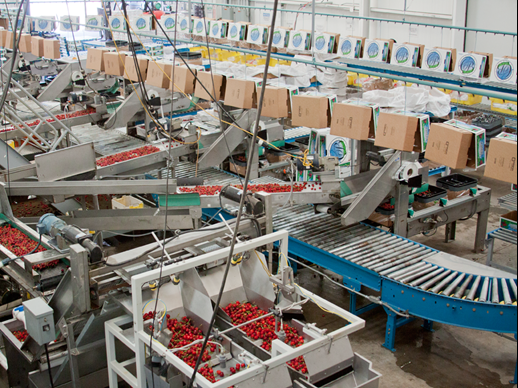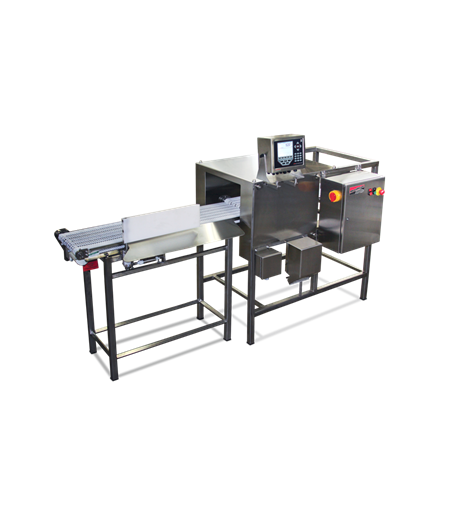Is the website displaying in the correct language? Please confirm or select a different language.
Your region has been set automatically. Please confirm or select a different region.

Cherries in Motion
In-motion MotoWeigh® generates quick ROI for end users on a cherry farm and processing facility.
Publish Date: 10/13/2013
From Growing and Picking to Packing and Shipping
Cherry season is chaos. Starting in May, California cherry farmers have six weeks to harvest, package, and ship their cherries before the warmth of summer sets in. With such a small window of time, any kink in the chain of events, from destructive weather to equipment malfunction, can prove to be catastrophic. Most farmers use a third party to pack and ship their product; however, Camera Brothers, located in Stockton, California, undertakes the entire process from growing and picking to packing and shipping.
Patti Azpeitia, controller of Camera Brothers, decided her operation needed an efficiency boost. Looking at the numbers, she estimated approximately 10% of her crop was being given away in overweight boxes. On top of that, product traceability and new barcode regulations were coming into effect—requirements her current equipment could not meet. An upgrade was in order.
LCE Systems, Inc. specializes in the produce industry and had a solution for Camera Brothers. An in-motion checkweigher could integrate into the existing process, but it would need to not only be reliable, but also fast enough to handle the cherry season’s demanding throughput.
Generating Quick ROI
“Joe and I were able to visit Rice Lake and demo MotoWeigh,” explains Daniel Cannistraci. “We saw how Rice Lake operates and wanted to work with the highest quality product, so we chose MotoWeigh for the application.”
Roger Lohrmeyer, who handles most of LCE’s programming, adds, “Counting scales are common, but in this environment, that scale needs to be able to make a change in a fraction of a second. Before MotoWeigh, I had never seen a product so seamless, especially at the speeds we wanted to run—240 feet per minute. The 920i® is easy to work with and we knew it could handle everything we would throw at it.”

Designing the Cherry Shed
LCE developed a plan to install the MotoWeigh. Camera Brothers was already thinking about remodeling the cherry shed and consulted with LCE to ensure the new equipment would be incorporated into the new shed design. With academic experience in architecture, Joe Ehlers drew up layouts and provided dimensional drawings for the proposed setup. Previously lacking a product delivery system, the shed now has a horseshoe belt to route full cherry boxes to the MotoWeigh. Stacks of boxes on either end of the shed are replaced with an overhead box carousel, continuously passing operators so they are never farther than an arm’s length from the constantly needed supply. LCE’s unique experience allows them to provide much more than scale expertise. “Prior to LCE, we all worked together at a packing facility,” explains Roger. “We all have experience in the produce industry and the day-to-day operations, and can make those small changes that make a big difference.”
From the Tree to the Box
With those small changes now in place, Camera Brothers is reaping big rewards. The shed’s system takes cherries from the tree to the box in a matter of minutes. First, cherries travel up an incline belt where cluster-cutters separate the stems. They then drop through gaps in the floor, with different gap widths determining cherry size. From there, cherries are sorted and sized one more time before going to the box fillers, after which filled boxes travel to the MotoWeigh. Once at the MotoWeigh, each box travels over the indexer, which spaces them out so only one box is on the scale at a time. A scanner reads the box’s barcode and sends that information to the 920i, which calls preset over/under/accept values. If the box is over or under tolerance, the 920i activates a diverter, sending it to a reject line at a smooth 45-degree angle. If a box is within the “accept” range, it continues on its conveyor, and an inkjet printer sprays nontoxic ink on the box. This information includes the type of cherry, size grade, GTIN barcode, and even the company logo. All information adheres to the 2012 Product Traceability Initiative which provides traceability standards and is becoming required by an increasing number of retailers.
Peak Performance
The first day the MotoWeigh was in production, however, it created some confusion. More boxes were being rejected than previously expected. The reject line operator was running out of room to stack the boxes. Surely, something must be wrong with the MotoWeigh. Using a CW-90 to double-check box weights confirmed that the rejected boxes were indeed out of tolerance. MotoWeigh was doing its job perfectly, rejecting all boxes more than one pound overweight. Also unexpected was the number of underweight boxes, which could result in high fines and potential canceled orders. With MotoWeigh in place, overweight and underweight boxes are not being shipped, and LCE estimates that the customer will see a great return on investment.
The Many Benefits of MotoWeigh
“MotoWeigh is an easy sell because people need it right now,” Daniel explains. “With increased emphasis on product traceability and GTIN barcodes, packaging facilities are panicking. If they don’t meet these requirements, retailers won’t buy their product.
Plus, there is the cost-saving benefit of the checkweigher itself; you throw that in and it’s a much easier sell. It seems like a lot of scale dealers are scared to touch motionweighing because it’s not traditional, but MotoWeigh is what the customer needs, so you have to adapt.”

Full In-Motion Solutions Provider
LCE’s specialty is becoming in-motion applications, but they pride themselves on customer service and giving the customer more than they expect. They set up complete networks of equipment that have been designed for specific packing applications. LCE started doing the front end, then worked their way to the back end with inkjet systems. Next, they are moving toward the middle with box filling, which would make LCE a complete one-stop-shop, benefitting the customer by calling one number instead of trying to contact all the people who worked on different parts of the system.
A Natural Partnership
Emphasis on customer service provides a natural pairing for LCE and Rice Lake Weighing Systems. Daniel remembers one of his first dealings with Rice Lake. “We needed a hanger for an old mechanical scale. The manufacturer wasn’t making the part anymore and couldn’t help us. We contacted Rice Lake, sent them the broken part, and had a custom-made replacement part sent back to us. We won the client’s full-time service business because of that experience. Rice Lake provides solutions when nobody else can.”
A Smooth Running System
"Before MotoWeigh, I had never seen a product so seamless, especially at the speeds we wanted to run—240 feet per minute."
–Roger Lohrmeyer, programmer for LCE Systems, Inc.
As differently sized boxes approach the scale, their bar codes are scanned to reference the correct over/under values stored in the 920i digital weight indicator. The diverter sends overweight and underweight boxes to a reject line. With MotoWeigh in place, overweight and underweight boxes are not being shipped, and LCE estimates that the customer will see a great return on investment.
Subscribe to Rice Lake Magazine
Sign in or create a Rice Lake website account to request a Rice Lake Magazine filled with application stories like this one be sent to you.
Account Sign In Create an Account


 My Account
My Account
